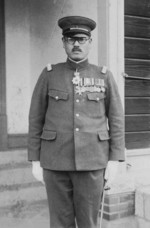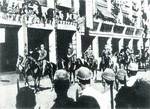Takashi Sakai
| Surname | Sakai |
| Given Name | Takashi |
| Born | 18 Oct 1887 |
| Died | 30 Sep 1946 |
| Country | Japan |
| Category | Military-Ground |
| Gender | Male |
Contributor: C. Peter Chen
ww2dbaseTakashi Sakai was born in Hara Village, Kamo District, Hiroshima Prefecture, Japan in 1887. He attended Kobe Junior High School, Osaka Army Preparatory School, and Central Army Preparatory School before before enrolling in the Japanese Army Academy, graduating in 1908. His first assignment was with the 28th Infantry Regiment at the rank of sub-lieutenant. He graduated from the Army Staff College in 1916. In 1924, he was promoted to the rank of major.
ww2dbaseIn 1928, Sakai was promoted to the rank of lieutenant colonel and was assigned to Jinan, Shandong Province, China with the 12th Infantry Regiment and also serving as a military attaché. On 3 May 1928, Sakai personally met with Chinese leader Chiang Kaishek, promising that the recent increase in Japanese military presence was to protect Japanese civilians in Jinan against a sudden upsurge of anti-Japanese ethnic violence. Within an hour of this meeting, the Jinan Incident began to the surprise of the Chinese. During the incident, over 6,000 Chinese civilians and soldiers were killed. A number of Chinese Army officers were captured and executed by the Japanese in Jinan; Chinese intelligence officers suspected Sakai of being the one responsible for giving the orders to kill them. Chinese leader Chiang Kaishek, at the time focused on unifying the country, chose to overlook Sakai at this time. In Chiang's diary entry dated 10 May 1928, however, he vowed to avenge the deaths of the officers, men, and civilians killed by the Japanese in Jinan. Chiang would bring up the shame suffered by China in Jinan a number of times in the subsequent years.
ww2dbaseBetween 1929 and 1932, Sakai was the chief of staff of the Tianjin Garrison. In 1932, he was promoted to the rank of colonel and was assigned to the 5th Section (military intelligence) of the 2nd Bureau of the Imperial Japanese Army General Staff; he held this position until 1934. Between Aug 1934 and Dec 1935, he was the Chief of Staff of the Japanese China Garrison Army. In this role, he played a major part in Japan gaining effective control of large areas of Hebei Province which surrounded the major northern city of Beiping; a number of his troop deployments were done without first consulting with military and political figures in Tokyo. In 1936, he was given command of the 23rd Infantry Regiment. In 1937, he was promoted to the rank of major general and was made the commanding officer of the 28th Infantry Brigade. In 1939, he was promoted to the rank of lieutenant general and was assigned to the Mongolian Garrison; he held concurrent positions as the Director of Zhangjiakou Special Affairs Agency and Director of the East Asia Development Board's Mengjiang Liaison Department between 1939 and 1940 (Mengjiang, located in the Inner Mongolia region of northern China, was a puppet nation under Japanese control; Zhangjiakou, also known by its Mongolian name of Kalgan, was its capital). He returned to Japan in 1940 as the commanding officer of the Imperial Guards Depot Division. In Nov 1941, he was made the commander of the 23rd Army base in Guangzhou, Guangdong Province, China. In Dec 1941, he was given temporary command of the 38th Division (which was formally a part of the Southern Expeditionary Army Group), with which unit he and his Chief of Staff Tadamichi Kuribayashi led across the border from China into British Hong Kong. He was initially given 10 days to conquer Hong Kong, but he took 18 days to complete the conquest; some historians suspected that this delay might have fueled his brutality toward the civilians during his co-governorship of Hong Kong with Admiral Masaichi Niimi. Sakai and Niimi were relieved by Rensuke Isogai in Feb 1942. Recalled to Japan, he was placed in reserve in Apr 1943. In Feb 1945, he was reactivated for a planned assignment in Beiping, but the war would end before he set foot back in China. He was arrested by US occupation forces after the war. In Dec 1945, the Chinese government demanded Sakai's extradition. Tried at the Nanjing War Crimes Tribunal, he was found guilty of war crimes on 27 Aug 1946, responsible for the extrajudicial killings of Chinese civilians through the chain of command. Some of the war crimes listed that fell under his responsibility included:
- 17-18 Dec 1941: The killing of 30 prisoners of war at the Lei Yue Mun Pass Coastal Battery
- 19 Dec 1941: The killing of 26 British medical personnel and two prisoners of war at the Salesian Missionary House advanced dressing station.
- 24-26 Dec 1941: The rape of 7 nurses (3 of whom died) and the killing of 60-70 wounded military servicemen at the field hospital at St. Stephen's College.
ww2dbaseA number of war criminals found guilty by the Chinese were given some degree of liniency, some due to American pressure, some due to Chiang Kaishek's willingness to build Sino-Japanese relations after the war. In the case of Sakai, however, Chiang refused to grant any form of mercy due to Sakai's betrayal of his own words at Jinan in 1928. On 30 Sep 1946, Sakai was executed by firing squad. Upon receiving word that Sakai's execution had been carried out, Chiang was said to have given a long sigh.
ww2dbaseSource: Wikipedia
Last Major Revision: Jul 2021
Takashi Sakai Interactive Map
Photographs
 |  |  |
Takashi Sakai Timeline
| 18 Oct 1887 | Takashi Sakai was born in Hara Village, Kamo District, Hiroshima Prefecture, Japan. |
| 3 May 1928 | Takashi Sakai met with Chiang Kaishek in Shandong Province, China, declaring that the Japanese troops in the Jinan area were tasked only with the protection of Japanese nationals, and promising that they would withdraw from Jinan within days. Chiang was persuaded of Sakai's sincerity. Within hours, however, Japanese troops would attack Chinese troops and civilians in the city. 18 Chinese officials were arrested and executed by the Japanese; Chinese intelligence later determined that Sakai might have personally given the order for the executions. |
| 2 Dec 1941 | Takashi Sakai was ordered to lead the Japanese 23rd Army, based in China, to cross the border into Hong Kong and to conquer it within 10 days of an outbreak of war with the United Kingdom. |
| 25 Dec 1941 | Masaichi Niimi and Takashi Sakai were named the co-governors of the Japanese Occupation Administration of Hong Kong. |
| 26 Dec 1941 | General Takashi Sakai and Admiral Masaichi Niimi paraded through Victoria, Hong Kong with the troops of the Japanese 38th Infantry Division. |
| 20 Feb 1942 | Rensuke Isogai was named the governor of the Japanese Occupation Administration of Hong Kong, relieving Masaichi Niimi and Takashi Sakai. |
| 27 Aug 1946 | In Nanjing, China, Takashi Sakai was found guilty of war crimes, by command responsibility, for the rape and extrajudicial killing of civilians and prisoners of war committed by his subordinates. |
| 30 Sep 1946 | Takashi Sakai was executed by firing squad on Yuhuatai Mountain in the southern side of Nanjing, China. |
Did you enjoy this article or find this article helpful? If so, please consider supporting us on Patreon. Even $1 per month will go a long way! Thank you. Share this article with your friends: Stay updated with WW2DB: |
» Jinan Incident
» Battle of Hong Kong
» Tokyo Trial and Other Trials Against Japan
- » 1,150 biographies
- » 337 events
- » 43,897 timeline entries
- » 1,241 ships
- » 350 aircraft models
- » 207 vehicle models
- » 372 weapon models
- » 123 historical documents
- » 260 facilities
- » 470 book reviews
- » 28,524 photos
- » 432 maps
Fleet Admiral Chester W. Nimitz, 16 Mar 1945
Please consider supporting us on Patreon. Even $1 a month will go a long way. Thank you!
Or, please support us by purchasing some WW2DB merchandise at TeeSpring, Thank you!